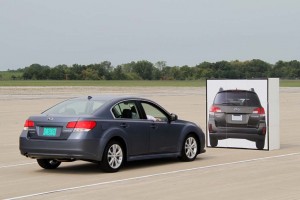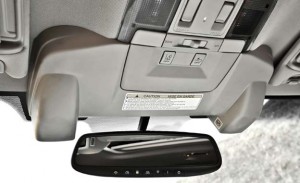It takes a leap of faith to step on the gas and take aim at the bumper of the car in front of you.
True, it’s actually just a life-size picture on the side of an oversized cardboard box but it requires serious willpower not to stomp on the brake at the last minute. But no need, it turns out. A moment before seeming impact, the Subaru Outback I’m driving issues a warning beep then automatically engages the brakes just in time to leave a 2-foot gap in front of my own bumper.
Credit the Japanese maker’s new EyeSight system, an advanced safety system that it is introducing on its new 2013 Subaru Legacy and Outback models.
EyeSight actually incorporates seven different safety features, explains vehicle line director Dave Sullivan, including Pre-Collision Braking, Lane Departure Warning, Active Cruise Control and Pre-Collision Throttle Management, among others.
Those terms may be familiar to those who’ve watched as automakers rapidly introduce an array of digital technologies designed to help prevent collisions – or reduce the severity when an accident occurs. What’s significant about EyeSight is the way Subaru has consolidated all seven safety features into a single umbrella system – as well as the fact that rather than having to rely on any number of radar, sonar or laser sensors to make it all work, EyeSight turns to a pair of stereoscopic cameras mounted just above the rearview mirror.
The system isn’t perfect. It has some flaws – such as the inability to “see” through heavy rain or a snow-covered windshield. But Subaru has come up with a technology that delivers a wide array of different technologies that should significantly reduce collisions while delivering it all at a surprisingly affordable cost.
The maker, meanwhile, says it is already working on the next-generation EyeSight — which would actually be Gen-3, the original version appearing in tech-crazy Japan in 2007 – and its goal, according to Sullivan, is to “eventually…offer this in every car line” Subaru of America sells.
To get a sense of how well the technology works, the maker has invited a small group of journalists out to the old Willow Run Airport on the far outskirts of suburban Detroit. The demo is surprisingly simple: we simply launch the car towards the target at about 20 miles per hour and then resist the urge to brake.
EyeSight’s twin cameras have, all the while, been staring ahead, unblinkingly snapping images of the road every tenth of a second. The two images are compared by its microprocessing system, much as a human brain uses the images from each of our eyes to detect motion and distance.
If EyeSight determines a collision is imminent it will sound a warning to alert the driver. If the motorist fails to act, the system will begin lightly applying the brakes. If there’s still no driver intervention EyeSight will use the vehicle’s maximum braking force – in this case bringing us to an abrupt stop just short of the “car” ahead.
It’s not a pleasant sensation, and Sullivan stresses that it is not meant to serve as a digital co-pilot taking over driving duties while the human behind the wheels texts or relaxes. In fact, after the third such automatic stop EyeSight will disable itself – warning the driver, of course – until the car is shut off and then restarted.
Equally important, Sullivan explains, “If the driver does do something,” like tapping the brakes or trying to steer away from the obstacle, EyeSight “will give back control. It will not override the driver.”
While fully autonomous cars are coming closer and closer to reality, EyeSight is not there yet.
Among the other functions, the system will also warn a driver who might be drifting out of their lane. And it features Active Cruise Control, letting the motorist set the preferred speed but then adjusting to the ebb and flow of traffic. EyeSight will even bring the vehicle to a complete halt, if necessary.
Subaru turned to partners such as Fujitsu to provide many of the components for EyeSight but did much of the basic development internally, an unusual move at a time when even safety-minded giants like Mercedes-Benz, Ford, Toyota and BMW rely heavily on assistance from suppliers such as Germany’s Bosch.
There are some advantages and disadvantages to that approach, Sullivan acknowledges, but Subaru sees EyeSight as “core technology” and intends to stay on top of it.
Perhaps the biggest problem with a camera-based system is that it can be blinded by heavy rain or snow – and is useless if the windshield is iced over in Window. And don’t touch the clear lens covers or you’ll need to replace them – though that’s apparently a quick and relatively low-cost repair.
EyeSight isn’t quite as quick or robust as some of the newest systems found in high-end luxury cars, such as the Toyota LS or BMW 7-Series, but it is nonetheless impressive to experience.
Could future versions incorporate additional sensors, such as radar to become even more effective? Maybe yes, maybe no, he says, though the executive confirms there’ll be still more powerful – meaning faster – processors in future versions.
Apparently, Subaru buyers have also been impressed with what they see with EyeSight. Though the technology is only available on the top end 2013 Legacy and Outback models, the “take rate” has been surprisingly high. Subaru is offering EyeSight as part of an upgrade package that also includes a moonroof and navigation system for $3,690 in the Legacy, $3,645 in the Outback. Were it a standalone option, Sullivan says, it would go for $1,290.
Expect to see EyeSight show up in other Subaru models – and very possibly for a lower price as volume pushes down production costs.


